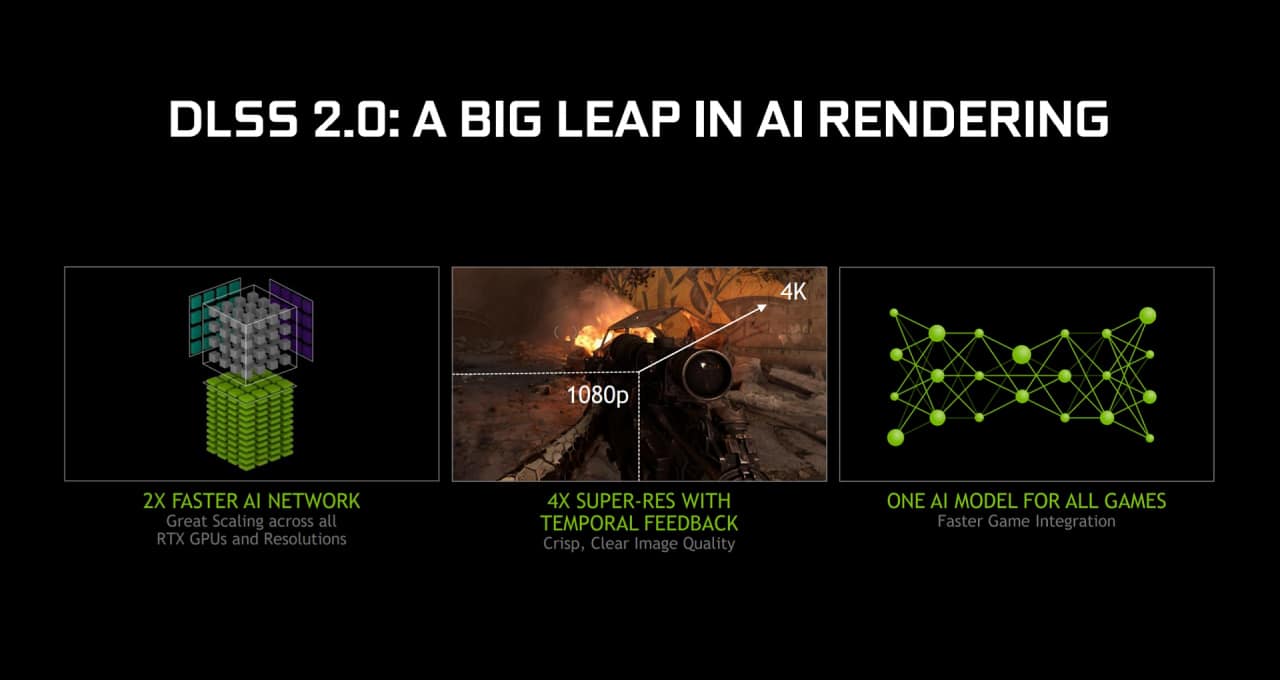With the graphics cards in the Geforce RTX 2000 family, Nvidia introduced the Deep Learning Super Sampling (DLSS) technology. As the name suggests, the technology is based on using machine learning and artificial intelligence to scale an image from a lower resolution to a higher one, where the goal is image quality that will match the higher resolution.
The technology is based on Nvidia’s server fleets continuously calculating scaling of images from low to high resolutions, and thus learns how to best scale images without noticeable visual deterioration. Local calculations are performed on the Tensor cores in the Geforce RTX 2000 series, but since much of the work has already been done in advance with AI training on Nvidia’s server parks, the load will be significantly lower than with traditional scaling.
Nvidia is now unveiling DLSS 2.0, where one of the big news is that the Tensor cores of graphics cards are used much more efficiently than before. Nvidia’s data state that this is now happening twice as fast as before, and that performance when scaling from low resolutions should be significantly better.
The next big step is in the scaling up itself. Where DLSS 1.0 could double the basic resolution, DLSS 2.0 can quadruple it, enabling upscaling from 1080p to 4K UHD. The technology now also accumulates more data over time, which is used to generate better image quality when scaled up. “Training” the technology for scaling up now also does not happen per game, which makes it easier to apply by more developers and new game titles.
DLSS 2.0 consists of three different quality settings. According to Nvidia’s Tony Tomasi, performance mode offers better performance than DLSS 1.0 with the same or better image quality, with the game Control as an example. Other quality modes include Quality, which, as the name suggests, increases image quality with lower performance, and Balanced, which strikes an intermediate position between the other two.
NVIDIA DLSS 2.0 basically gives our players a free performance boost, without sacrificing image quality. It was also super easy to implement with NVIDIA’s new SDK, so it was a no brainer for us to add it to MechWarrior 5.
In connection with the unveiling, Nvidia also presents games that support DLSS 2.0. One of the big names is last year’s Control from the Finnish game studio Remedy Entertainment. Mechwarrior V also gets DLSS 2.0, and according to developer Piranha Games, this game provides a free performance enhancement without sacrificing image quality.
In Nvidia’s presentation, the Mechwarrior V gets approximately 33 percent better performance at 1440p resolution on the Geforce RTX 2060 graphics card with performance mode enabled. When the quality mode is used, the image quality is said to be more detailed with DLSS 2.0 at the same resolution, compared to when the image is rendered in true 1440p.
In addition to DLSS 2.0, Nvidia’s presentation also touches ray tracingadd-ons in the Vulcan interface, which coincidentally are based on a previous extension from Nvidia. The company also announces that an upcoming update of the game engine Unreal Engine will be fully integrated with Microsoft ray tracingDirectX Raytracing (DXR) interface.
DLSS 2.0 is sharply used in the game titles Deliver us the Moon, Wolfenstein: Youngblood and Mechwarrior V: Mercenaries. Support for the technology will also be added to the game Control on March 26.
Have you used DLSS in any of the games that support the technology? What do you think about the image quality it offers versus performance benefits?















